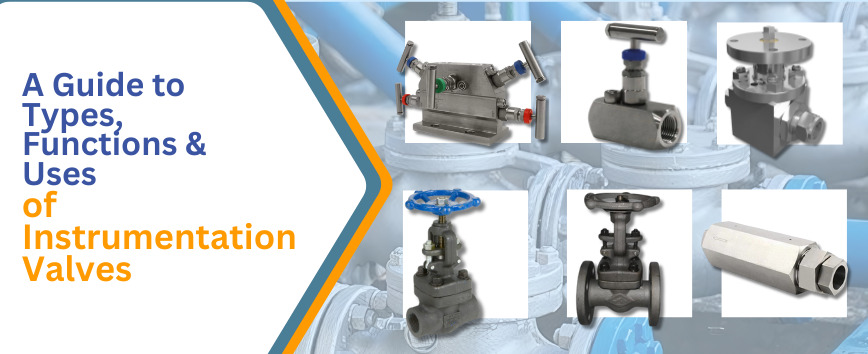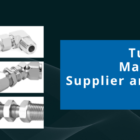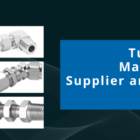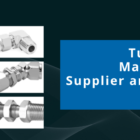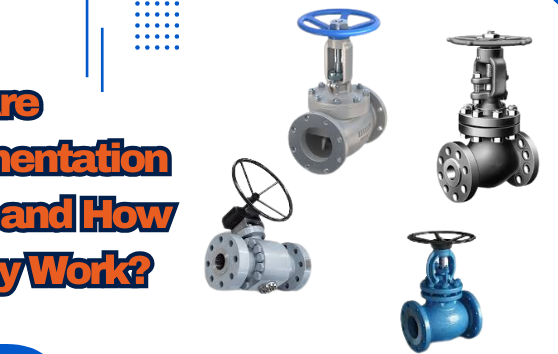Valves are integral to any industrial system, controlling the flow of liquids, gases, and slurries. They ensure smooth operation, safety, and efficiency in various applications, from household plumbing to complex industrial processes. This guide will explore different types of industrial valves, their functions, and their applications.
Understanding Valves
Valves are devices that control the flow of fluids (liquids, gases, or even slurries). They act like switches, opening, closing, or partially blocking passageways to regulate pressure and direction. Valves are essential in everything from plumbing systems to industrial pipelines, ensuring smooth operation and safety.
Valves are used in requests wherever instrumentation measurement follows. Valves are used for separation, venting, block & bleed, stagnant pressure, complete pressure, gauge pressure, differential pressure, liquid level & instrument lines
Types of Industrial Valves
In nearly all sectors, there are several kinds of valves used to control the flow of liquid or gas. Valves are installed on equipment to perform the following functions:
- Starting/Stopping of fluid flow.
- Controlling the amount of fluid flow.
- Controlling the direction of fluid flow and preventing backflow.
- Regulating the downstream system or process pressure.
There are various types of valves used in the industry.
- Manifold valves: Manifold valves combine multiple valves into a single body, simplifying the installation process and reducing space requirements. They are commonly used in instrumentation systems to control the flow of fluids and gases. Applications include pressure and flow measurement systems in industries like oil and gas, petrochemicals, and power generation.
- Needle valves: Needle valves offer precise control of flow rate with a slender, tapered needle-like plunger. They are ideal for calibration and fine-tuning applications in industries such as chemical processing and instrumentation. Their precise regulation capabilities make them essential in laboratory and testing environments.
- Ball valve: Ball valves feature a spherical disc to regulate fluid flow, providing reliable sealing and quick shutoff. They are widely used in industrial applications like oil and gas pipelines, water treatment, and chemical processing. Known for their durability and easy operation, they are suitable for high-pressure and high-temperature environments.
- Check valve: Check valves prevent backflow in a piping system, ensuring unidirectional flow. They are crucial for maintaining system integrity in applications like water and wastewater management, oil and gas, and power plants. These valves automatically close if the flow reverses, protecting equipment from damage.
- Globe valve: Globe valves regulate flow with a movable disc that adjusts against a stationary ring seat. They are excellent for throttling and frequent operation in systems requiring precise flow control, such as cooling water, fuel oil, and turbine lube oil systems. Their design allows for efficient flow regulation and easy maintenance.
- Gate Instrumentation valve: Gate valves control the flow of liquids by lifting a gate out of the path of the fluid, providing minimal restriction when fully open. They are used in applications requiring a straight-line flow of fluid with minimal pressure drop, such as in water distribution and wastewater treatment. These valves are suitable for on-off control without throttling capabilities.
Functions of Industrial Valves
- Manifold valves: Combine multiple valves into one body for simplified installation and reduced space requirements, commonly used in instrumentation systems.
- Needle valves: Offer precise control of flow rate with a tapered needle-like plunger, ideal for calibration and fine-tuning applications.
- Ball valve: Regulate fluid flow with a spherical disc, providing reliable sealing and quick shutoff, widely used in industrial applications for their durability and ease of operation.
- Check valve: Prevent backflow, ensuring unidirectional flow to maintain system integrity, crucial for various industries including water management and power plants.
- Globe valve: Regulate flow with a movable disc against a stationary ring seat, excellent for throttling and frequent operation in systems requiring precise flow control.
- Gate valve: Control flow by lifting a gate out of the fluid path, providing minimal restriction when fully open, suitable for applications requiring straight-line flow with minimal pressure drop.
Uses of Industrial Valves
| Valve Type | Use/Industry |
| Manifold Valve | Instrumentation Systems |
| Needle Valve | Chemical Processing, Instrumentation |
| Ball Valve | Oil and Gas Pipelines, Chemical Processing |
| Check Valve | Water Management, Power Plants |
| Globe Valve | Cooling Water Systems, Fuel Oil Systems |
| Gate Valve | Water Distribution, Wastewater Treatment |
Choosing the Right Instrument Valve:
Choosing the right instrument valve is crucial for ensuring optimal performance and safety in various applications, you can select the right instrument valve to meet the specific requirements of your application and achieve optimal performance and reliability.Here are some key factors to consider:
- Application Requirements: Understand the specific requirements of your application, including pressure, temperature, flow rate, and media compatibility.
- Valve Type: Select the appropriate valve type based on the intended function. For example, needle valves offer precise flow control, while ball valves provide quick shutoff and globe valves are suitable for throttling.
- Material Compatibility: Ensure that the valve materials are compatible with the media being handled to prevent corrosion or contamination. Common materials include stainless steel, brass, and various plastics.
- Pressure and Temperature Ratings: Verify that the valve’s pressure and temperature ratings meet or exceed the operating conditions of your system to avoid failure or leakage.
- Size and Connection Type: Choose the right valve size and connection type to ensure compatibility with your piping or tubing system.
Maintenance and Repair:
- Regular Inspection: Check valves periodically for any signs of wear, leaks, or damage. Look for rust, corrosion, or loose parts.
- Cleaning: Keep valves clean from dirt and debris. Use a soft brush or cloth to remove any buildup. This helps prevent clogs and ensures smooth operation.
- Lubrication: Apply lubricant to moving parts according to the manufacturer’s recommendations. This keeps the valve operating smoothly and prevents friction-related damage.
- Tightening: Check for loose bolts or nuts and tighten them if necessary. Loose fittings can cause leaks and reduce valve effectiveness.
- Replacing Seals: If you notice leaks, it may be due to worn-out seals. Replace them promptly to prevent further leakage.
- Testing: Regularly test valves to ensure they open and close properly. This can be done manually or using automated systems if available.
- Repairing Leaks: If you find leaks, determine the source and repair it. This may involve replacing damaged parts or resealing connections.
- Professional Help: For complex repairs or if you’re unsure, it’s best to seek help from a qualified technician or plumber.
Summary:
Choosing the right instrument valve is essential for ensuring efficient operation, safety, and longevity in industrial systems. By understanding the specific requirements of your application and considering factors such as valve type, material compatibility, and pressure ratings, you can select the most suitable valve for your needs. Whether it’s controlling flow rates in chemical processing or preventing backflow in water management systems, the proper selection of valves is critical for optimal performance and reliability.
With careful consideration and adherence to industry standards, you can ensure that your instrumentation valves meet the demands of your application and contribute to the overall success of your operations.


